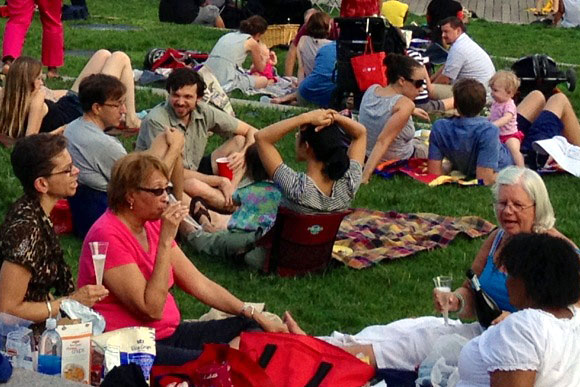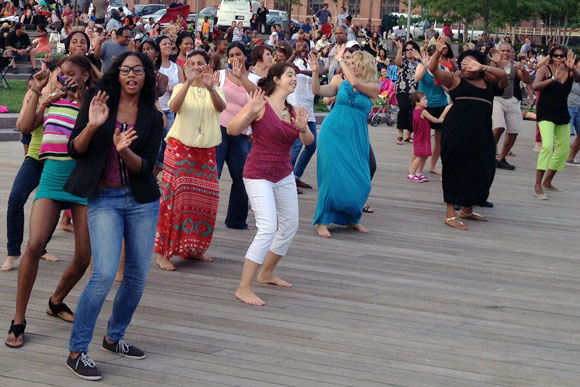Cozied along the Anacostia River between the Nationals Ballpark and Navy Yard,
Yards Park's interactive water fountains, sculptural bridge and summer concert series take it a few notches above the average neighborhood playground.
But, since the park was completed in 2010, it's taken a lot of work — and a unique partnership — to keep it that way.
Yards is the only park in the city that's owned by the District, yet run by a private entity — in this case, a nonprofit business improvement district.
Michael Stevens, executive director of the
Capitol Riverfront Business Improvement District (BID), says the city sought an organization to maintain and operate the park in an on-the-ground way that the District, with limited funds, could not.
Since his BID, a 501(c)(6) nonprofit, was launched in 2007 to maintain, market and encourage economic development in the burgeoning Capitol Riverfront neighborhood, taking on a similar role for the park made sense.
Next City, a nonprofit publication that focuses on urban planning trends, recently
designated such public-private partnerships as one of the innovations that has changed cities for the better over the past year, as private entities have stepped into public funding gaps to maintain open spaces. The newly opened Brooklyn Bridge Park in New York City, which is owned by the city, was planned, built and is being maintained by a nonprofit by the same name as the park. And similar partnerships have found success in Philadelphia, Cincinnati and other metro areas.
In the District, such partnerships are rare, since many public spaces—including the National Mall, Rock Creek Park, Hains Point, and a number of public squares, traffic circles and even many "triangle parks" across the city—are owned by the National Park Service. Yards Park is different.
A vision and hard work
The D.C. Council kicked off the vision for the 500-acre space — a manufacturing hub where the Navy Yard employed some 30,000 workers making ship parts during World War II — to be redeveloped into a mixed-use neighborhood. Started in the late '90s, the development now includes residential, retail and commercial spaces designed to showcase the community space provided by Yards Park, built by developer Forest City Washington (which also built many of the offices, restaurants, and residences that have sprung up in the past five years). An expanded Metro station in 2007 and the reopening of Nationals Park the following year helped kick off the neighborhood's more recent growth.

Stevens says the public-private partnership has worked for several reasons, including the BID's ability to be "more nimble" in procuring contracts than a government entity can be.
"We can do things quicker and faster, because we can get contracts faster," Stevens says.
But the BID has run into some of the same financial difficulties, mostly linked to the recent economic downturn, that would have made maintaining a city-run park difficult.
Sales taxes on retail spaces that front Yards Park, for example, will help pay for its maintenance — once they are filled with tenants.
"Unfortunately, due to the recession, many of those buildings that should have been open were stalled," Stevens says. (He then listed more than half a dozen new restaurants and attractions scheduled to open this year, including the
microbrewery Bluejacket, a
Buzz Bakery and Mexican, Italian and barbecue eateries.)
The park's current operating budget is around $650,000 and includes a combination of long-term and temporary revenue streams, such as a three-year allocation from a D.C. government bond (which will end this year) and five years of voluntary contributions from the developer to maintain landscaping.
The BID generates other funds by renting out parts of the park for special events, and a grant from CSX Transportation helps pay for the park's Friday-night concert series in the summer.
More retail businesses opening this year will help bolster the budget, with the BID scheduled to receive up to $380,000 in sales tax generated once the Lumber Shed building is up and running. Until July 2017, the sales tax that would normally go to the District goes straight into a special fund for park maintenance.
But Stevens says still more money is needed to maintain and operate the park as a subsidiary of the BID, without taking away from its staff and $1.7 million budget to run and market the overall 500-acre Capitol Riverfront neighborhood.
A similar relationship?
While the partnership behind Yards Park is unique, there are other public-private relationships that help the city clean — though not necessarily run — some of its parks.
Rick Reinhard, deputy executive director of the
Downtown DC BID, says the nonprofit has a general management agreement with the National Park Service to maintain and clean a square mile of city space in its focus area — which happens to include 32 parks.

The BID has a team of 85 safety and maintenance workers who pick up litter and empty trash in the area. Occasionally, the BID helps the Park Service with "special projects," like keeping the federally owned McPherson Square tidy during the Occupy DC protests last year.
Reinhard says a partnership like the one at Yards Park becomes more difficult when working with the Park Service or other federal agencies in the heart of D.C. Unlike local parks, the federally owned parks come with specific rules, such as alcohol and signage restrictions, that make running them — or hosting events on the properties — more difficult.
"Because [these parks] are owned by the National Park Service, it makes it extremely challenging to move ahead with a partnership like the one at Yards Park," Reinhard says.
But, for Yards Park, the unique setup is keeping the park running smoothly — well-manicured grass and all.